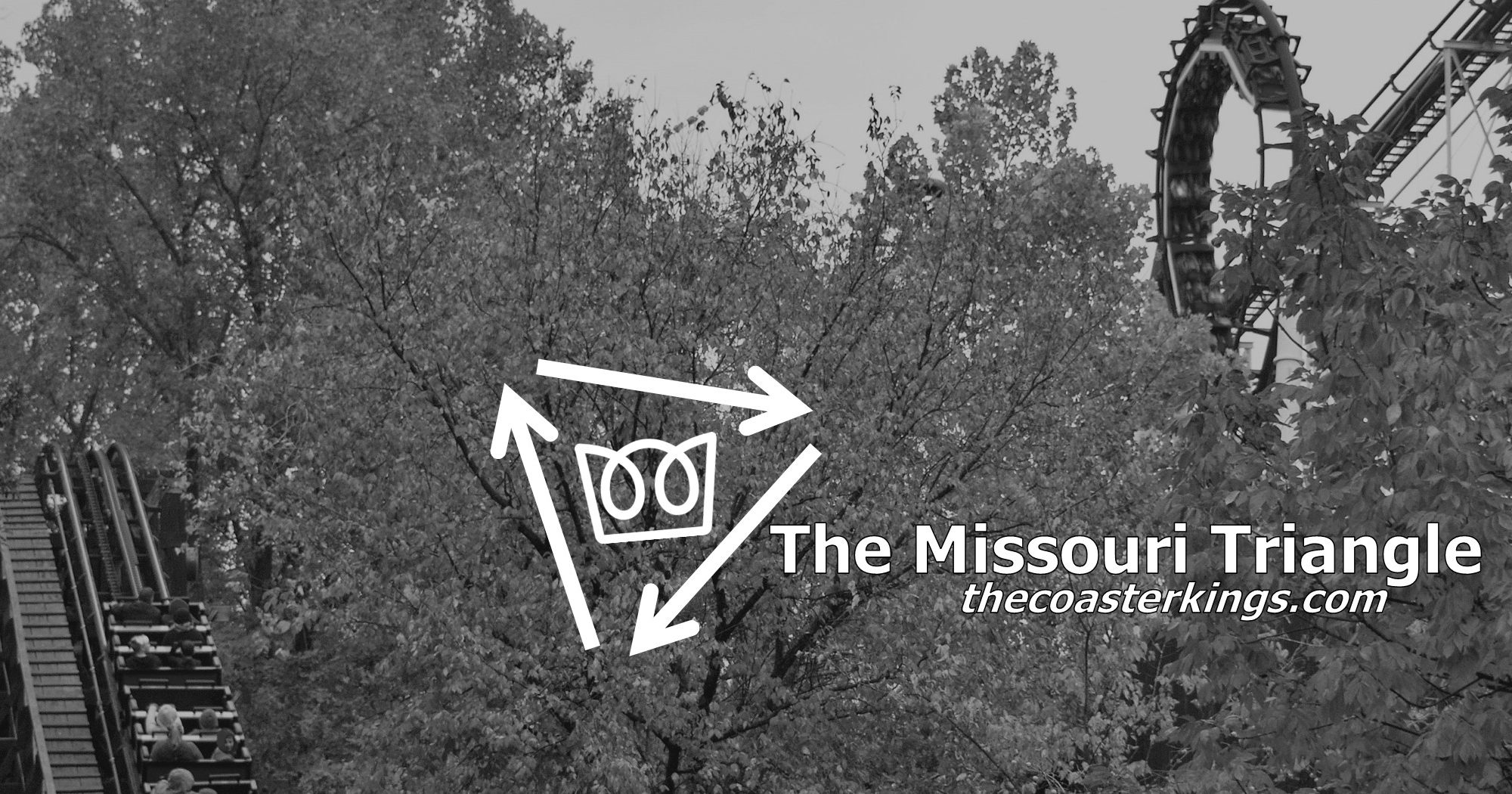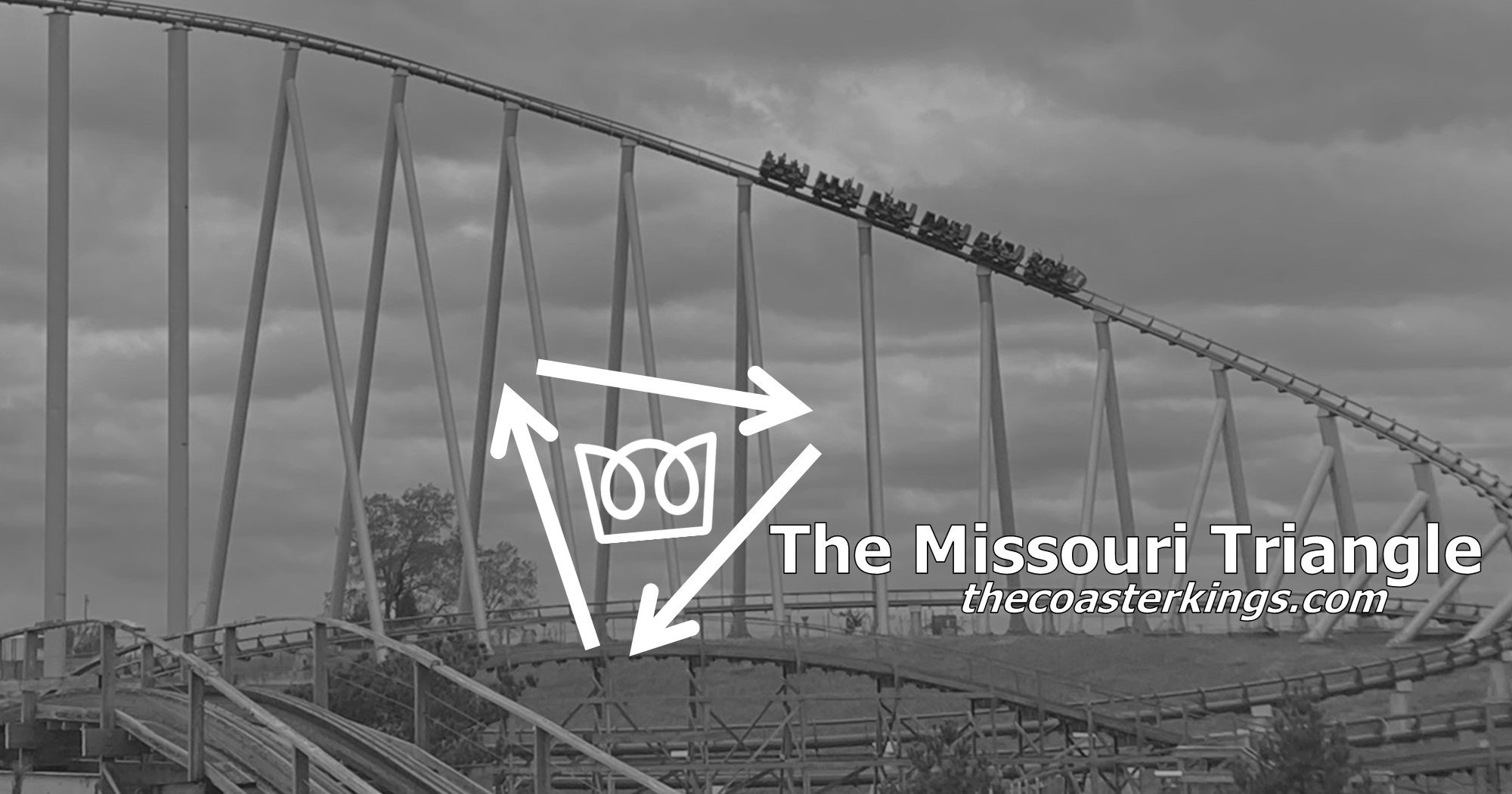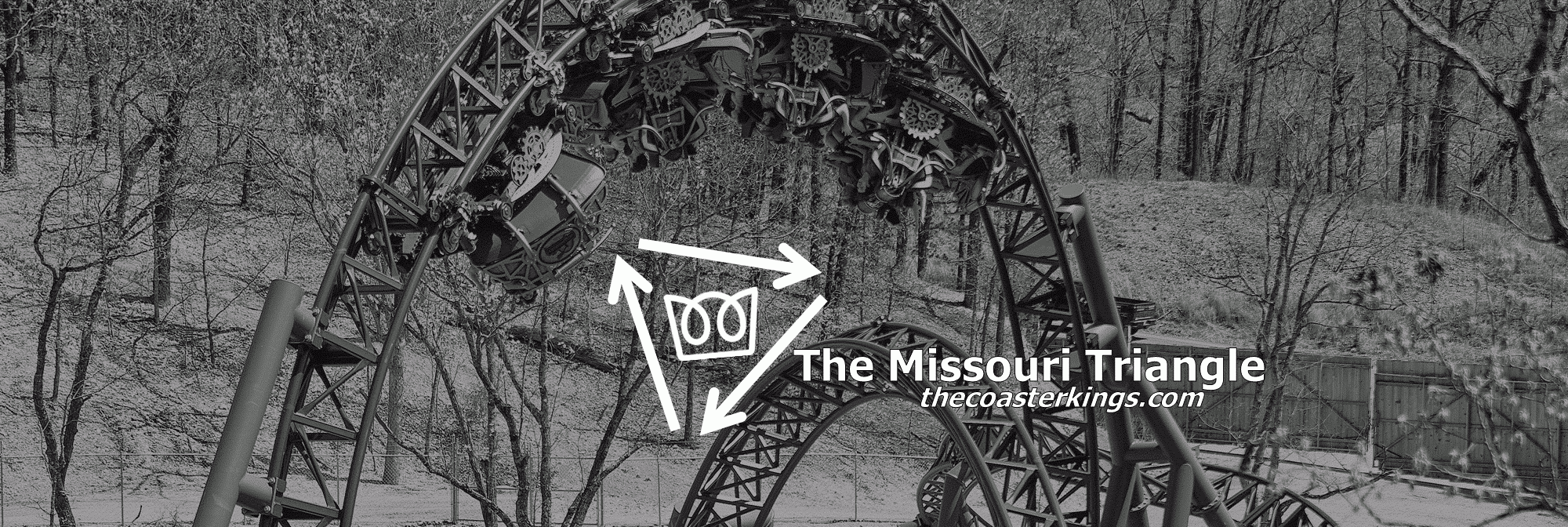It’s that time a year again! Welcome to Coaster Kings’ 3rd annual Twenty Year Top 20, where we count down our picks for the twenty best coasters turning 20 in 2021!
Continue reading “Twenty-Year Top 20: The Best Coasters of 2001”The Missouri Triangle: Part 3 – Six Flags St. Louis
After a shorter day at Worlds of Fun, Pete and I had come to our final day and park of the Missouri Triangle. Six Flags St. Louis opened in 1971 as the third and final Six Flags park developed under the vision of Angus Wynne – before expansion switched from new park development to acquisition. It is apparent that the concept had been streamlined by the third try. While the six flag-themed areas remained, far less emphasis was placed on nation specific theming. By the 70s it was obvious rides are why people went to Six Flags and the park opened with multiple of what made the Six Flags concept work: two Arrow log flumes, two Arrow mine trains, and two Arrow car rides. While the park has undergone some dramatic changes through the years, it benefits from this simplified formula, and, despite the changes, the park feels cohesive. What was it about this “lower-tier” Six Flags park that made it a highlight of our trip?
Continue reading “The Missouri Triangle: Part 3 – Six Flags St. Louis”The Missouri Triangle: Part 2 – Worlds of Fun
In part one of this series my friend Pete and I started our Missouri trip with an amazing Thursday at Silver Dollar City. Friday’s park was one of Cedar Fair’s mid-tier parks, Worlds of Fun. Worlds of Fun opened in 1973 at the height of the regional park boom. Despite some dramatic changes since the park’s 1995 sale to Cedar Fair, Worlds of Fun still very much feels like a product of the 70s. Loosely themed to Jules Verne’s Around the World in 80 Days, the park is divided into various international regions such as Europa, Africa, and the Orient. These areas are more distinguished than I expected and are united by a streamlined 70s aesthetic. For coaster enthusiasts World of Fun features some impressive coasters including the tallest full-circuit coaster in the state, Mamba and the well regarded GCI woodie, Prowler. The biggest question for the two of us was how did this Cedar Fair property compare to it’s Ohio siblings.
Continue reading “The Missouri Triangle: Part 2 – Worlds of Fun”The Missouri Triangle: Part 1 – Silver Dollar City
There is lots of debate over what state in the US has the best coaster collection. Most conversation centers on California, Pennsylvania, and Ohio, but there’s one state that usually overlooked. With three major theme parks and a significant collection of World class coasters, Missouri is one of the most underrated coaster destinations in America. With the end of seasonal park season on the horizon, my friend Pete and I decided to make the trek from Ohio to visit these three major parks which I’m dubbing “The Missouri Triangle.”
Continue reading “The Missouri Triangle: Part 1 – Silver Dollar City”Paris’ Regional Destination: Parc Astérix!
Just outside of Paris is one of Europe’s biggest regional parks: Parc Astérix! While the destination comes from an ambition to build a major park in Paris before Disney could come in and do it, the 1989 theme park is very much different than Disney and offers some fun alternative themes and experiences. Do you still want to go for a resort visit? Parc Astérix has you covered with several onsite resort hotels!
Continue reading “Paris’ Regional Destination: Parc Astérix!”Pennsylvania Weekend: Part 1 – Knoebels
For us enthusiasts living in areas affected by seasons, the spring is always an exciting time to look forward to. This year I launched the coaster season with a whirlwind trip to Pennsylvania to check out some of the world’s best coasters. Accompanied by my patient boyfriend Andrew and our friend Pete, we embarked on a two day, one night trip from Columbus, Ohio to Knoebels in Elysburg, Pennsylvania and Hersheypark in Hershey, Pennsylvania.
Continue reading “Pennsylvania Weekend: Part 1 – Knoebels”Throwback Series: Leofoo Village
We’re back with a follow-up to our Janfusun FancyWorld Throwback, featuring a relatively obscure park that boasts an impressive variety of Intamin rides: Leofoo Village!
Continue reading “Throwback Series: Leofoo Village”How To – U.S.A. Parks
In this series of articles the Coaster Kings teams look to share some advice that will help our readers plan their travel. This week Ian outlines the steps to prepare for a trip to a theme park in the United States. This article is specifically geared towards American theme parks in general. Look for articles on the Disney and Universal resorts in the future!
Continue reading “How To – U.S.A. Parks”Lost Coasters of California – Part 9: Stealth
Paramount Park’s 13 year foray into the theme park business resulted in a significant number of successes and industry oddities. The application of Paramount theming in existing regional parks gave us two significant B&M Top Gun inverts and the world’s first major linear induction motor launch coaster, Flight of Fear. However their tendency to experiment and take additions in different directions also resulted in a string of failures and disappointments. Kings Dominion opened the late Volcano, The Blast Coaster in 1998, a prototype Intamin inverted catapult coaster that never seemed to run reliably throughout its 20 years at the park, and the ill-fated prototype air launch coaster Hypersonic XLC in 2001. Carowinds opened a Setpoint suspended water coaster in 2000 called Flying Super Saturator which lasted less than 10 years. Canada’s Wonderland still has an odd collection of mid-size coasters for the world’s most popular regional park including 1995’s SLC Top Gun and 2004’s Zamperla flyer Tomb Raider, The Ride. The chain’s flagship, Kings Island, received one of the most notorious failures of them all, 2000’s wooden hyper coaster, Son of Beast. That same year the chain would add a unique prototype to Great America, the world’s first major flying coaster, Stealth.
Continue reading “Lost Coasters of California – Part 9: Stealth”Spanish Theme Park History – Part 4: Parque de Atracciones de Madrid
Today we’ll continue our series about the Spanish Theme Park History with the fourth article. Every two weeks we’re publishing one of eight articles about the history of thirteen Spanish amusement and theme parks. Some of them no longer exist, but some others are still operating and receiving guests nowadays. In this series, we travel in time through 168 years in theme park history, starting in 1853, to our days in 2021. In this article we’ll focus on Parque de Atracciones de Madrid, a park with lots of history, an interesting variety of rides and attractions, that is constantly evolving to offer the best experiences to its guests.
Continue reading “Spanish Theme Park History – Part 4: Parque de Atracciones de Madrid”Lost Coasters of California – Part 8: Invertigo
Last week we focused on Windjammer Surf Racers and how it was a product of Knott’s Berry Farm’s attempt to navigate the space between the family and thrill market. It faced the problem of Magic Mountain dominating the thrill market with major coaster additions, many of which we’ve discussed here, and Disneyland’s hyper detailed themed experiences. Northern California in the late 90s had a far less competitive theme park market. After the construction and runaway success of Tidal Wave in 1977 Marriott’s Great America, eventually Great America in 1985 and then Paramount’s Great America in 1993, had remained consistent with coaster trends. In 1986 they opened the wooden Grizzly, 1991 saw the addition of the B&M standup Vortex, and 1993 saw the addition of the still-beloved B&M invert Top Gun. These consistent additions, despite changes in ownership, resulted in a solid coaster collection any regional park could be proud of.
Continue reading “Lost Coasters of California – Part 8: Invertigo”2nd Hand Coasters
Five of the Best Parks in America for Relocated Roller Coasters
You can’t build new old coasters – any park could conceivably build a new ride from scratch, but there’s something about a relocated coaster that feels unique. A ride on its 2nd or 3rd location is also on its 2nd or 3rd lease on life, or even its 2nd or 3rd identity. Parks with multiple relocated coasters dedicate themselves to continuing the stories of these rides – many of which whose narratives were thought to have already ended.
Continue reading “2nd Hand Coasters”Lost Coasters of California – Part 7: Windjammer
Today’s roller coaster landscape is becoming increasingly international. With the rise of streaming video, social media, and even Google Translate the coaster enthusiast community and industry is more connected than it’s ever been. With the recent rise of Chinese theme parks and Chinese ride manufacturers it’s easy to forget a time when Japan seemed second only to the United States as a thrill ride destination. The undisputed king of the Japanese coaster manufacturers was “Toyo Goraku Ki Kabushiki Kaisha” or TOGO. TOGO opened their first roller coaster in 1953 at Hanayashiki park in Tokyo and soon began building rides all over Japan. In 1983 their stand-up coaster model was opening at Kings Island as King Cobra, bringing TOGO to North America. Over the next two decades TOGO would try to capitalize on this success and expand into the American and European market. They eventually opened a subsidiary named TOGO International headquartered in Middletown, Ohio. While there was some success an ill-fated 1997 project at Knott’s Berry Farm would mark the end of TOGO’s presence as a leader in the coaster world.
Continue reading “Lost Coasters of California – Part 7: Windjammer”Lost Coasters of California – Part 6: Flashback
Last week I discussed the short lived Psyclone at Magic Mountain. Psyclone’s trains designed by Swiss manufacturer Bolliger and Mabillard caused much of it’s woes. This week’s article looks at the first coaster these designers worked on, and one with lasting impacts in the coaster industry.
Continue reading “Lost Coasters of California – Part 6: Flashback”Lost Coasters of California – Part 5: Psyclone
In Part 4 we looked at the construction and eventual transformation of California’s tallest wooden coaster, Colossus. Today’s lost coaster resided at the same park. This story includes a natural disaster, a young Swiss ride manufacturer, and the unfortunate death of a coaster design icon.
Continue reading “Lost Coasters of California – Part 5: Psyclone”Lost Coasters of California – Part 4: Colossus
When a park sets out to build the biggest, fastest, and baddest coaster around the problem always arises that its records and stature will eventually be surpassed. For Magic Mountain’s Colossus this was not a problem for much of its life. From its construction in 1978 until the construction of Viper in 1990 it was the tallest full circuit coaster in all of California. After Viper Colossus reigned as the king of the California wooden coasters until it’s RMC conversion in 2014, passing the crown to the nearby GhostRider.
Continue reading “Lost Coasters of California – Part 4: Colossus”Lost Coasters of California – Part 3: Tidal Wave
As we discussed in the last article on the Whizzer the Marriott’s Great America parks were bold designs that applied many lessons learned at other regional parks. Part of this was a plan and specific plots designated for expansion. In 1977, a year after its opening, the Santa Clara park was the first to receive a major coaster addition, the Tidal Wave.
Continue reading “Lost Coasters of California – Part 3: Tidal Wave”Lost Coasters of California – Part 2: Whizzer
In Part 1 of this series we explored Corkscrew which left Knott’s Berry farm in 1989 but lives on at Silverwood. Today we look at another steel classic that left the state a year earlier in 1988 and also lives on, albeit in spirit, at a different park.
Continue reading “Lost Coasters of California – Part 2: Whizzer”Lost Coasters of California – Part 1: Corkscrew
The Golden State has long had the reputation as one of the recreation capitals of the world. Beautiful weather combined with a diverse landscape created an environment where leisure became a serious business. It is no surprise that California is home to some of the world’s most famous roller coasters. Unfortunately many great rides are no longer part of the California coaster landscape. In these series we will be exploring some of California’s great coasters that are no more!
Continue reading “Lost Coasters of California – Part 1: Corkscrew”Twenty-Year Top 20: The Best Coasters of 2000
Following the launch of our Twenty-Year Top 20: The Best Coasters of 1999, we immediately decided to make it an annual thing – Here’s what we think are the 20 best coasters that turned 20 in 2020!
Continue reading “Twenty-Year Top 20: The Best Coasters of 2000”











